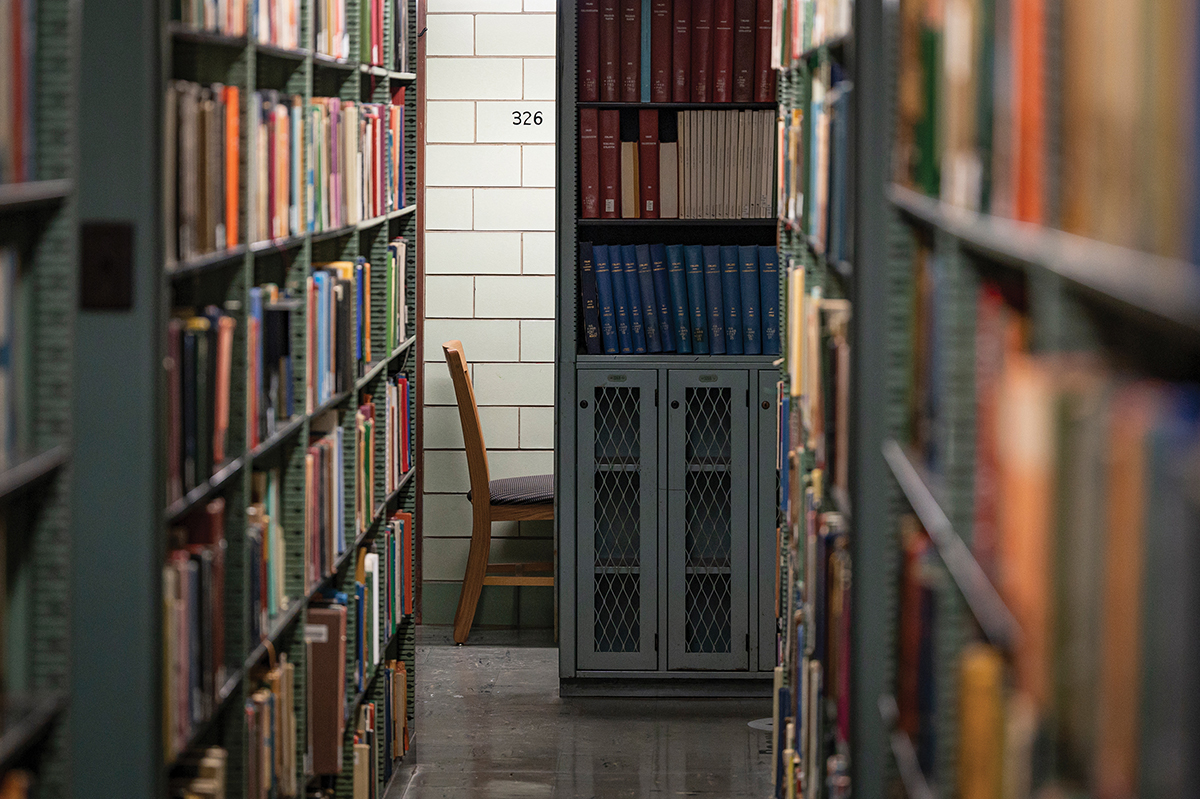A Little Creepy but Totally Quiet
Studying in Memorial Library’s cages has been a rite of passage for generations of students.

The silence and isolation of carrel 326 helped our writer finish this article in record time. Bryce Richter
I was too intimidated to study in Memorial Library’s carrels — commonly called the cages — when I was a UW–Madison student. This feels like a legal confession as I sit in carrel 326 in the north stacks writing these words. Above me is exposed ductwork and a fluorescent light. To one side is a concrete-block wall coated in olive green. To the other side is a steel mesh door with spots of rust bleeding through the turquoise paint.
This one doesn’t lock, but some do. A desk, shelves, a wall outlet, a coat hook, a no-smoking decal, and someone’s leftover English literature sticky notes finish the roughly four-foot-by-four-foot metal box. With promised silence and isolation, this is a study spot that has everything a student needs to finish a class paper.
But there’s no way around it: the carrel feels a bit like a jail cell.
Opened in 1953, Memorial Library was the state’s biggest building project since the Wisconsin capitol in 1917. A key feature was constructing some 400 study carrels for graduate students along the perimeter of the massive stacks. By 1955, the cage was all the rage.
“The carrels continue [to be] a popular feature … so much so that, at examination time, stack permits are passed around by students who otherwise could not get in,” stated a library report from the time.
Studying in the confined cubicles has become a rite of passage for generations of students. Two years ago, the Wisconsin Alumni Association put out a call for memories, and dozens of alumni responded with nearly unanimous (though measured) fondness.
“I spent hours in [the carrels] doing my dissertation,” wrote Marie-Louise Mares MA’90, PhD’94. “The faint smell of dry paper in the stacks is my Proustian trigger.”
“I felt locked in, away from the world to concentrate,” added Jane Hillstrom ’80. “They were a necessary-evil experiment in learning.” (Or as Kristin Bergsland Caffrey ’80 concisely described them: “a little creepy but totally quiet.”)
Today, graduate students can apply for one of the 175 locked carrels and reserve it for up to two years, allowing them to safely store weighty tomes. There are also 219 “open carrels” available to any scholar who seeks solitude.
As I take a writing break and check out the carrels in the south stacks, my curiosity turns to envy. These look less like jail cells and more like doctors’ offices. The walls are plastered and painted a pleasant beige. There’s more wood and less metal. I suspect these carrels — and those with windows in the north stacks — are in high demand.
And here’s a final confession, as I pack up from carrel 326: I finished this story in record time.
Published in the Spring 2022 issue



Comments
Debbie Rose April 4, 2022
I remember Fondly studying in the dead silence of the carrels! It was one of the only places that I could find quiet. The only problem was trying to find an available one! I don’t remember the ability to reserve them in the early 1980’s but that may have been that I just did t know how to reserve them! The carrels had many odd people in them too, in addition to those just looking for a Urey place to study. I remember many nights spending most of the night there. Shutting down the Memorial library hecame routine!
Stephen Kaeppler April 4, 2022
Study in the stacks was my favorite place to study on campus. I have very fond memories of studying in the stacks on winter evenings and including at least one time in March on a particularly balmy 50 degree day. I will also add that studying the stacks was truly a unique experience to UW. Having went to the University of Iowa for graduate school and now teaching at Clemson University, neither of these places had/have study spaces that match the unique character of the stacks.
Jim Hendrickson May 10, 2022
I got locked in here one New Years Eve when I didn’t realize they were closing early. Talk about creepy!